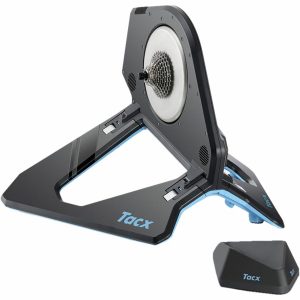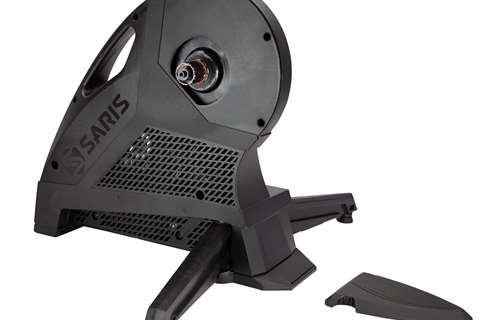Von Collins is an accomplished triathlete and endurance cyclist, and the author of four fitness and training books: Smarter Running, Your First Triathlon Guide, Fit Foods, and 30 Rut-Busting Workouts. He has been cited as a triathlon, cycling, and fitness expert by Healthline, CNET, Forbes, Eat This, Not That and other major outlets.
When it comes to smart trainers, there are really three that I consider top contenders. The Saris H3 and the Sharis H3 Plus just might be my favorite of the bunch right now, especially when factoring-in the price tag.
A few big changes have happened at CycleOps over the past couple years, especially when it comes to smart trainers. First, CycleOps went through a rebranding to more closely align with the parent company, Wisconsin-based Saris. In other words, Saris = Cycleops. Saris, the maker of some of our favorite bike carriers and power meters, owns the legacy CycleOps brand.
Then, Saris rolled-out a new and vastly improved smart trainer, the H3. The H2 had been built and marketed for a few years, but while it was a good, reliable performer, it had a couple flaws. The H3 fixed those.
Finally, Saris unveiled the H3 Plus, a riff on the H3 which includes a built-in cassette (so you don’t have to install one) and is even a bit quieter than the H3.
The bottom line: The Saris H3 lineup is now our favorite trainer on the market, when factoring in the price tag.
Find the H3 on Amazon, here.
Buy directly from Saris, here.
Saris H3 Competition
I have ridden most of the smart trainers on the market, and given them a good indoor test. Based on that riding, I would consider the main H3 competitors as being the Tacx Neo, perhaps the Tacx Flux models, and the Wahoo KICKR. All are great models that I review separately, and make some mention of below. There are other smart trainers on the market, but we consider these three to be the ones that are most reputable and have stood the test of time.
My H3 Riding Experience

I gave the Saris H3 an extensive test ride using both Zwift and Trainerroad. I was impressed by the overall riding experienced, when compared to its main competitors. I love several things about the model, not to mention its stability on the floor, the overall responsiveness, and the relatively quiet noise level.
The H3’s setup was relatively fast. I say relatively because you will need to assemble a cartridge on the unit, which you can try doing yourself or drop it off at a local bike shop to do – it is a simple job for them. Either way, that is really the only setup wrinkle. Everything else connects surprisingly fast. No fumbling with your riding app to try to find the H3 – it happens almost instantly.
Being a big guy who likes to ride hard, I am a stickler when it comes to a unit that is wobbly, connects poorly or loses its connection, or is too noisy at high wattage. While the old H2 model was highly-competent but had a couple shortcomings, including excessive noise at higher power. Based on my test rides, I think the H3 addressed the shortcoming and is right up there with the Tacx models, which have always been the gold standard for noise.
There are some who think that Saris just just kind of keeping pace with the competitive landscape, but we think the H3 is a product they should be proud of, and at the peak of the market in terms of performance.
The maximum power output is 2,000 watts, so more than enough for any avid cyclist. If you are needing more than 2,000 watt capacity for your workouts, allow me to introduce you to the Olympic committee.
H3 Connectivity and Compatibility
The overall connectivity of the H3 to your favorite apps is pretty seamless. We typically are trying to connect either to an Ipad tablet, or to an Apple TV device (in the case of Zwift). Either way, the H3 recognizes the connection quickly, and no messing with the firmware is required.

After testing the unit for several weeks, we only noticed a couple dropped connections. It was unclear if that was from the unit itself or from the receiving device.
Our conclusion is that, whether you are using Zwift, Sufferfest, Rouvy, Trainerroad, or another app, the H3 is going to find and connect to the app with ease. This is consistent with the H2, which always had a great reputation for finding and holding on to the connection with the app or the Apple TV device.
The H3 is compatible with all major indoor cycling apps, including Zwift, Rouvy, Trainerroad, Sufferfest and others. It is officially Zwift-certified, and actually comes with a free month of Rouvy.
Noise
The most noticeable improvement in the H3 when compared to the H2 is a no brainer. It is quieter. Way quieter.
The H3 Plus seems to be even a touch quieter. That might be because the pre-installed cartridge with your gearing is professionally done at the factory, and the cartridge is often the cause of some of the latent cycling noise.
We love that Saris took all the feedback on the “whine” that the H2 put out, and focused on fixing the problem in the H3. Don’t get us wrong, the H2 is a great trainer and one that we rode LOTS of miles on, but there is a whine that is a little annoying at first. You tune it out after a while.
The H3 has a new drive system that greatly reduces the sound. The company says the sound is dampened by about 5 times, and that is feasible if you compare to the H2. It may not have the silence level of the Tacx Neo, but there is a point where you can just say it is “quiet enough”. And we think the H3 is definitely quiet enough.
More exactly, Saris says that the sound output on the H3, at 20mph, is 59 decibels. We don’t have a decibel meter, but can tell you that it is quieter than the H2 by a long shot.
Accuracy
The accuracy of the H3 appears to be very good. According to Saris, you can expect power to be within 2% of actual. The only true way to test the power accuracy is to ride the trainer at the same time as using a separate power meter, and we have not yet done that. We plan to run that test in the next 30 days, and when we do we will post the results.
However, the wattage at the exertion levels we are familiar with appear to line-up to within 5% (or less) and the responsiveness has been very good when increasing or decreasing power.
There is some disagreement in the market on if running the unit hot vs. cold impacts the power readout by much. However, the H3 has improved cooling capabilities, so we think this is less of a factor than it was in the H2, or in the KICKR which we have found to get pretty hot after running at higher wattage.
Likewise, the reading from any smart trainer when the unit is completely cold could always be a bit off. Many prefer to ride the trainer for 10 minutes before doing any type of true calibration.
Mounting and Drive

An H3 is a direct-drive trainer, meaning the rear wheel comes off and you mount the bike directly into the trainer, with a rear sprocket on your trainer serving as the resistance. Your chain then connects directly to that sprocket. This is the way that the KICKR and Neo connect as well.
If you get the Saris H3 Plus, you have the hub and cartridge pre-installed, which is really nice. It is the only trainer that offers this feature other than the Wahoo KICKR. The regular He does not come with a pre-package cassette or sprocket (but if you buy direct from Saris you can choose from a set of options during the order process). If you don’t have a sprocket wrench handy, or are simply not someone who likes to work on your bike, this might be the most delicate part of the entire setup. Once you have the sprocket all set, mounting the bike to the trainer is a breeze.
When it doubt, bring the unit into your bike shop, buy a new cassette and pay them the few bucks to put it on for you.
Another nice advantage of a smart trainer, compared to a regular bike trainer, is that the mounting tension is much more relaxed. I have known of many cyclists who cringe about clamping their carbon-fiber frame to the trainer, and the tension it puts on the seat stay and chain stay. A smart trainer connects and fastens in a way that feels much friendlier to the frame.
When you setup your H3 and bike, you may want to opt for a bike trainer mat. It will help stabilize everything, and protect the floor beneath from scuffs and sweat. Saris makes a good one that may or may not come with your trainer.
Safety

Safety is an underrated factor of smart trainers, especially if you have young children around. We know from experience, kids see you on the bike setup, hear the buzz, and are attracted to it. You just can’t keep them away.
Using a smart trainer vs. a regular trainer removes one of the main moving parts — the big rear wheel — from the equation.
One thing we really like about the H3 (and all of the Saris / Cycleops smart trainers) is that they also conceal their flywheel. Everything is inside the casing. That might make it less convenient when you need to work on it, which should not happen often if ever. But it makes it MUCH safer around children, in our opinion. A hot, exposed flywheel, like the one you get on a KICKR, has the potential to injure or burn someone who did not realize how fast it is moving or how warm it can get.
I think the H3’s flywheel design is superior for this underrated but very practical factor.
As for other safety features, the H3 can handle riders up to 300 lbs. Above that, you may want to talk to the company to be sure that you will be safe riding the trainer.
Durability
Anytime I have ridden on a Saris smart trainer, I have been impressed with the durability. I have give it a beating, and it remains stable and I’ve never had a problem.
The Saris / CycleOps brand is one I have had very good durability luck with over the years. That goes not only for the H3, but also for the H2 that has gotten many, many hours of riding, as well as the more traditional trainers which we put through the wringer.
A feature of the H3 that I have to think will aid in the overall lifespan of the unit is its internal cooling fan — something that smart trainers historically have not had. This should keep the flywheel from operating at ultra-high temps, and we know that the hotter the temp, the more key components, bearings and friction points tend to wear.
Price Point
At $600 to $700, I consider the Saris H3 and the H3 Plus to be a best buy. It is less expensive than some of the models that I consider to be its direct competition — the Wahoo KICKR ($1,200) and the Tacx Neo ($1,400). Considering that the H3’s functionality is a big leap forward from the previous generation, being $200 to $400 less than the other brands models gives you a better overall deal. The KICKR and Neo are great smart trainers, but the H3 is found a great price point for itself given its performance and features.
Saris makes a very strong case selling this unit for around $700. That is a good value in my opinion.
You can buy it here.
Saris H3 vs. Wahoo KICKR
The Wahoo KICKR probably provides the stiffest overall competition for the H3, largely because both brands have been around for a long time, and the Wahoo is priced just a couple hundred dollars above the H3.
Let’s start with that price topic. For what you get, we think that the H3 is a better value for the money right now. Both are good, reliable, responsive, and quiet smart trainers from companies who have been building them for a while. But one is $200 less, and that one is the H3.
For a gadget-hound or gear-junkie, the KICKR still has a decided edge. For additional $$, you can have the ability to really simulate a climb by incorporating the indoor grade simulator on your front fork (we were skeptical of this when it came out, but it has been getting great reviews.) And the KICKR Axis feet allow some slight side-to-side movement, further simulating a real, outdoor ride. Plus, you can fully integrate your third party powermeter as another metric on your output.
Keep in mind that the H3 offers some incline simulation as well, just not as full. For comparison, the H3 can simulate a 20% incline, while the Wahoo KICKR with the Climb add-on can do both 20% incline and 10% decline.
But for the typical rider who is just looking to hop on Zwift or Sufferfest a few times a week, and get a good sweat, many of these features are optional. We don’t want to tell you which features are important to you, but we think that for 80% of the riders, the functionality of the H3 is more than enough.
Additionally, we prefer the Saris concealed flywheel to the Wahoo’s exposed flywheel. It is just safer with young children or pets around.
With all that said, I’m not throwing any shade at Wahoo. We did a Wahoo KICKR Review and liked a lot of what we saw. We have always liked the KICKR and would happily ride it (which you can find here).
Saris H3 vs. TACX Neo
The Tacx Neo 2T is the smart trainer that you buy if you have a nice budget to work with, and really value something that is smooth and sleek.
 We’re not going to lie, the Neo is one cool unit. First off, its design is stunning. It is sleek, minimalist, and just looks like a next-generation rig sitting in your workout room. Second, it is absolutely silent. This thing is so quiet that you could probably use it in your baby’s bedroom while they are sleeping, and the only noise would be from you cursing at the screen. Third, it packs a lot of functionality into that sleek unit, including the ability to simulate 25% inclines and crank out 2,200 watts if you need it. Compare that to the H3’s 20% incline and 2,000 watts.
We’re not going to lie, the Neo is one cool unit. First off, its design is stunning. It is sleek, minimalist, and just looks like a next-generation rig sitting in your workout room. Second, it is absolutely silent. This thing is so quiet that you could probably use it in your baby’s bedroom while they are sleeping, and the only noise would be from you cursing at the screen. Third, it packs a lot of functionality into that sleek unit, including the ability to simulate 25% inclines and crank out 2,200 watts if you need it. Compare that to the H3’s 20% incline and 2,000 watts.
But It all comes at a price for the Neo 2T: That price is about $1,400. That means it is a cool $400 more than the H3. It is a superior unit in several respects, but in terms of the fundamental ability to make you sweat and get you in better shape, the difference is marginal. Don’t overlook the step-down Tacx model, the Flux 2. We did a Tacx Flux 2 review and liked what we saw.
If you have the budget, you gotta take a look at the Neo (here). But if you are trying to get the best value, we think the H3 might suit your needs just fine.
Saris H3 vs. Saris (or CycleOps) H2
In case you are comparing the Saris H3 to the Saris (CycleOps) H2, we wanted to spend a minute on the two. The fact is that you can pick up an H2 at discontinued model pricing, which means it might be $100 or more less than the H3 — making it an appealing way to get in to the smart trainer market. You would have a new — albeit discontinued — product.
The benefits of the newer H3 are mainly in the quieter drive belt and drive system, which significantly reduces the noise from the unit, as well as the internal cooling fan. The better drive belt will eliminate the “whine” that so many of us who have logged miles on the H2 can relate to, and the cooling system will theoretically help the unit last longer — but only time will tell. When it comes to a $1,000 purchase, I really like to do a 3-year lookback versus over analyze things after a month or two. Problem is, in 3 years, there will no doubt be a better model to review.
Beyond those two benefits, you are going to have the same reliable firmware — keep in mind that firmware is really not dependent on the model. Saris’ firmware can be updated just like an app as the latest versions are released. And it appears that the H2 and H3 have overall accuracy, similar stability, and a similar overall design and body. We have put the H2 through hours of hard tests, and it is holding up well. We have the assume that the H3 will have similar durability.
We think the H3 is worth an extra $100 over the H2, given the advancements. If you start seeing the H2 for half the price of the H3, then it might be worth it if you are trying to save a few bucks. But let’s be clear — the H3 is a superior smart trainer.
Saris H3 vs. Peloton
Comparing the H3 to the Peloton is a bit of an apples-and-oranges proposition. The H3 allows you to ride your own bike while working out to Zwift or Trainer Road or other apps. Peloton is more turnkey, but requires you to ride their bike and with the Peloton app. Some will prefer the Peloton, but most people who are training for next year’s triathlon season or century rides prefer to train on their own bike, making the H3 one of the best alternatives to Peloton for the money.
My Advice on the Saris H3 Trainer
I think the Saris H3 is one of the best all-around trainers on the market today, and suitable for any rider. It can handle those harder or heavier rides who need big power capacity or a more durable unit. The price is right. Along with the Tacx Flux, I think the H3 is in the sweet spot of the functionality and price equation.
Where to get the Saris H3
There are two places we recommend checking-out for your new Saris H3, both highly-reliable. The pricing will generally be about the same, but if you find someone doing a discount, snag it! Here are the three go-to places I have been finding the H3, often at a discount:








You left out Elite?
Regarding Saris H3 failure rate data. I think there is plenty of data regarding failure rate of the H3. For example my H3 is making a lot of noise after 140 hours or riding.
You can search YouTube and find others having problems with their H3. Just think about all the people that don’t post on YouTube. Heck it seems to me that all smart trainers are having problems.
What kind of failure data are you looking for?
You mention the prices but when you mention price differences you seem to imply they’re a couple hundred closer in price than the stated prices.
Why do you test on Zwift and Trainerroad? Any chance you would also test on Rouvy? Would be curious about the opinion from someone experienced.
What about 12 speed compatibility?
Good question. It will work, but you might get some chain mashing. You get to put your own cassette on so a little bit of spacing might be required to get it just right.